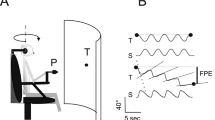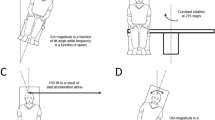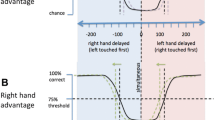Abstract
Perception of tilt (somatogravic illusion) in response to sustained linear acceleration is generally attributed to the otolithic system which reflects either a translation of the head or a reorientation of the head with respect to gravity (tilt/translation ambiguity). The main aim of this study was to compare the tilt perception during prolonged static tilt and translation between 8 and 20° of tilt relative to the gravitoinertial forces (i.e., G and GIF, respectively) when the semicircular cues were no more available. An indirect measure of tilt perception was estimated by means of a visual and kinesthetic judgment of the gravitational horizon. The main results contrast with the interpretation regarding the tilt/translation ambiguity as the same orientation relative to the shear forces G for the true tilt or GIF in the centrifuge did not induce the same horizon perception. Visual adjustment and arm pointing in the centrifuge were always above the ones observed in a G environment. Part of the lowering of the judgment in the centrifuge may be related to the mechanical effect of GIF on the effectors as shown by the shift of the egocentric coordinates in the direction of GIF. The role of the extravestibular graviceptors in the judgment of the degree of tilt of one’s own body relative to G or GIF was discussed.



Similar content being viewed by others
References
Angelaki DE, Dickman JD (2000) Spatiotemporal processing of linear acceleration: primary afferent and central vestibular neuron responses. J Neurophysiol 84:2113–2132
Angelaki DE, McHenry MQ (1999) Short-latency primate vestibuloocular responses during translation. J Neurophysiol 82:1651–1654
Angelaki DE, McHenry MQ, Dickman JD, Newlands SD, Hess BJ (1999) Computation of inertial motion: neural strategies to resolve ambiguous otolith information. J Neurosci 19:316–327
Benson AJ (1990) Sensory functions and limitations of the vestibular system. In: Warren R, Wertheim AH (eds) Perception and control of self-motion. Lawrence Erlbaum, Hillsdale pp 145–170
Bock O (1994) Scaling of joint torque during planar arm movements. Exp Brain Res 101:346–352
Bringoux L, Schmerber S, Nougier V, Dumas G, Barraud PA, Raphel C (2002) Perception of slow pitch body tilts in bilateral labyrinthine-defective subjects. Neuropsychologia 40:367–372
Bringoux L, Tamura K, Faldon M, Gresty MA, Bronstein AM (2004) Influence of whole-body pitch tilt and kinesthetic cues on the perceived gravity-referenced eye level. Exp Brain Res 155:385–392
Brown JH (1966) Interacting vestibular stimuli and nystagmic habituation. Acta Otolaryngol 62:341–350
Carriot J, Bringoux L, Charles C, Mars F, Nougier V, Cian C (2004) Perceived body orientation in microgravity: effects of prior experience and pressure under the feet. Aviat Space Environ Med 75:795–799
Carriot J, Charles C, Huffenus AF, Nougier V, Raphel C, Cian C (2005) Effect of low gravitational stimulation on the perception of target elevation: role of spatial expertise. Percept Psychophys 67:1044–1051
Clark B, Graybiel A (1949a) Apparent rotation of a fixed target associated with linear acceleration in flight. Am J Opthalm 32:549–557
Clark B, Graybiel A (1949b) Linear acceleration and deceleration as factor influencing nonvisual orientation during flight. J Aviat Med 20:92–101
Clark B, Graybiel A (1966) Perception of the visual horizontal in normal and labyrinthine defective observers during prolonged rotation. Am J Psychol 79:608–612
Clement G, Deguine O, Parant M, Costes-Salon MC, Vasseur-Clausen P, Pavy-LeTraon A (2001) Effects of cosmonaut vestibular training on vestibular function prior to spaceflight. Eur J Appl Physiol 85:539–545
Coello Y, Orliaguet JP, Prablanc C (1996) Pointing movement in an artificial perturbing inertial field: a prospective paradigm for motor control study. Neuropsychologia 34:879–892
Cohen MM (1973) Visual feedback, distribution of practice, and intermanual transfer of prism aftereffects. Percept Mot Skills 37:599–609
Cohen MM (1977) Disorienting effects of aircraft catapult launchings: III. Cockpit displays and piloting performance. Aviat Space Environ Med 48:797–804
Cohen M, Stopper A, Welch R, DeRochia C (2001) Effects of gravitational and optical stimulation on the perception of target elevation. Percept Psychophys 63:29–35
Curthoys IS, Halmagyi GM (1999) Vestibular compensation. Adv Otorhinolaryngol 55:82–110
Curthoys IS, Betts GA, Burgess AM, MacDougall HG, Cartwright AD, Halmagyi GM (1999) The planes of the utricular and saccular maculae of the guinea pig. Ann NY Acad Sci 871:27–34
DiZio P, Li W, Lackner JR, Matin L (1997) Combined influences of gravitoinertial force level and visual field pitch on visually perceived eye level. J Vestib Res 7:381–392
Dickman JD, Angelaki DE, Correia MJ (1991) Response properties of gerbil otolith afferents to small angle pitch and roll tilts. Brain Res 556:303–310
Droulez J, Darlot C (1989) The geometric and dynamic implications of the coherence constraints in three-dimensional sensorimotor interactions. In: Jeannerod M (ed) Attention and performance. Erlbaum, New York pp 495–526
Fernandez C, Goldberg JM (1976) Physiology of peripheral neurons innervating otolith organs of the squirrel monkey. III. Response dynamics. J Neurophysiol 39:996–1008
Fernandez C, Goldberg JM, Abend WK (1972) Response to static tilts of peripheral neurons innervating otolith organs of the squirrel monkey. J Neurophysiol 35:978–987
Fitger C (1976) Tactile-kinesthetic space estimation: the influence of gravity. Psychol Res 39:113–135
Gentaz E, Hatwell Y (1996) Role of gravitational cues in the haptic perception of orientation. Percept Psychophys 58:1278–1292
Ghafouri M, Archambault PS, Adamovich SV, Feldman AG (2002) Pointing movements may be produced in different frames of reference depending on the task demand. Brain Res 929:117–128
Gooey K, Bradfield O, Talbot J, Morgan DL, Proske U (2000) Effects of body orientation, load and vibration on sensing position and movement at the human elbow joint. Exp Brain Res 133:340–348
Graybiel A (1952) Oculogravic illusion. AMA Arch Ophthalmol 48:605–615
Guedry FE (1974) Psychophysics of vestibular sensation. Handbook of sensory physiology. Kornhuber HH, New York, pp 1–154
Guedry FE, Mortensen CE, Nelson JB, Correia MJ (1978) A comparison of nystagmus and turning sensations generated by active and passive turning. In: Hood JD (ed) Vestibular mechanisms in health and disease. Plenum, New York, pp 317–325
Holly JE, McCollum G (1996) The shape of self-motion perception-I. Equivalence classification for sustained motions. Neuroscience 70:461–486
Howard IP, Templeton WB (1966) Human spatial orientation. Wiley, London
Ito Y, Gresty MA (1997) Subjective postural orientation and visual vertical during slow pitch tilt for the seated human subject. Aviat Space Environ Med 68:3–12
Lackner JR, DiZio PA (2003) Adaptation to rotating artificial gravity environments. J Vestib Res 13:321–330
Lackner JR, DiZio P (2005) Vestibular, proprioceptive, and haptic contributions to spatial orientation. Annu Rev Psychol 56:115–147
Li W, Matin L (1993) Eye & head position, visual pitch, and perceived eye level. Invest Ophthalmol Vis Sci 34:1311
Li W, Matin L (1995) Differences in influence between pitched-from-vertical lines and slanted-from-frontal horizontal lines on egocentric localization. Percept Psychophys 57:71–83
Loe PR, Tomko DL, Werner G (1973) The neural signal of angular head position in primary afferent vestibular nerve axons. J Physiol 230:29–50
Long GM, Ambler RK, Guedry FE Jr (1975) Relationship between perceptual style and reactivity to motion. J Appl Psychol 60:599–605
Luyat M, Gentaz E, Corte TR, Guerraz M (2001) Reference frames and haptic perception of orientation: body and head tilt effects on the oblique effect. Percept Psychophys 63:541–554
MacDougall HG, Curthoys IS, Betts GA, Burgess AM, Halmagyi GM (1999) Human ocular counterrolling during roll-tilt and centrifugation. Ann N Y Acad Sci 871:173–180
Matin L, Li W (1992) Mislocalizations of visual elevation and visual vertical induced by visual pitch: the great circle model. Ann N Y Acad Sci 656:242–265
Matin L, Li W (1994) The influence of a stationary single line in darkness on the visual perception of eye level. Vision Res 34:311–330
Matin L, Li W (1995) Multimodal basis for egocentric spatial localization and orientation. J Vestib Res 5:499–518
Mayne R (1974) A systems concept of vestibular organs. In: Handbook of sensory physiology. Springer, Berlin Heidelberg New York, pp 493–580
McIntyre J, Stratta F, Droulez J, Lacquaniti F (2000) Analysis of pointing errors reveals properties of data representations and coordinate transformations within the central nervous system. Neural Comput 12:2823–2855
Merfeld DM, Zupan LH (2002) Neural processing of gravitoinertial cues in humans. III. Modeling tilt and translation responses. J Neurophysiol 87:819–833
Merfeld DM, Zupan LH, Gifford CA (2001) Neural processing of gravito-inertial cues in humans. II. Influence of the semicircular canals during eccentric rotation. J Neurophysiol 85:1648–1660
Merfeld DM, Park S, Gianna-Poulin C, Black FO, Wood S (2005a) Vestibular perception and action employ qualitatively different mechanisms: II. VOR and perceptual responses during combined tilt & translation. J Neurophysiol 94(1):199–205
Merfeld DM, Park S, Gianna-Poulin C, Black FO, Wood S (2005b) Vestibular perception and action employ qualitatively different mechanisms: I. Frequency response of VOR and perceptual responses during translation and tilt. J Neurophysiol 94(1):186-98
Paige GD, Tomko DL (1991) Eye movement responses to linear head motion in the squirrel monkey. II. Visual-vestibular interactions and kinematic considerations. J Neurophysiol 65:1183–1196
Prieur JM, Bourdin C, Vercher JL, Sares F, Blouin J, Gauthier GM (2005) Accuracy of spatial localization depending on head posture in a perturbed gravitoinertial force field. Exp Brain Res 161:432–440
Raphel C, Barraud PA (1994) Perceptual thresholds of radial accelerations as indicated by visually perceived eye level. Aviat Space Environ Med 65:204–208
Raphel C, Barraud PA, Koessler C, Cian C (1996) Effects of a visual frame and of low radial accelerations on the visually perceived eye level. Percept Psychophys 58:906–914
Schöne H (1964) On the role of gravity in human spatial orientation. Aerosp Med 35:764–772
Seidman SH, Telford L, Paige GD (1998) Tilt perception during dynamic linear acceleration. Exp Brain Res 119:307–314
Si X, Angelaki DE, Dickman JD (1997) Response properties of pigeon otolith afferents to linear acceleration. Exp Brain Res 117:242–250
Tremblay L, Elliott D (2003) Contribution of action to perception of self-orientation in humans. Neurosci Lett 349:99–102
Vailt D, Mittelstaedt H, Baisch F (1997) Shifts in blood volume alter the perception of posture. Int J Psychophysiol 2:99–105
Vailt D, Mittelstaedt H, Saborowski R, Stark R, Baisch F (2002) Shifts in blood volume alter the perception of posture: further evidence for somatic graviception. Int J Psychophysiol 44:1–11
Wertheim A, Mesland B, Bles W (2001) Cognitive suppression of tilt sensations during linear horizontal self-motion in the dark. Perception 30:733–741
Whiteside TC, Graybiel A, Niven JI (1965) Visual illusions of movement. Brain 88:193–210
Worringham CJ, Stelmach GE (1985) The contribution of gravitational torques to limb position sense. Exp Brain Res 65:38–42
Zupan LH, Merfeld DM, Darlot C (2002) Using sensory weighting to model the influence of canal, otolith and visual cues on spatial orientation and eye movements. Biol Cybern 86:209–230
Acknowledgement
The authors are grateful to Mr Alain ROUX of the Centre de Recherches du Service de Santé des Armées for the technical expertise and helpful assistance.
Author information
Authors and Affiliations
Corresponding author
Rights and permissions
About this article
Cite this article
Carriot, J., Barraud, PA., Nougier, V. et al. Difference in the perception of the horizon during true and simulated tilt in the absence of semicircular canal cues. Exp Brain Res 174, 158–166 (2006). https://doi.org/10.1007/s00221-006-0434-6
Received:
Accepted:
Published:
Issue Date:
DOI: https://doi.org/10.1007/s00221-006-0434-6




